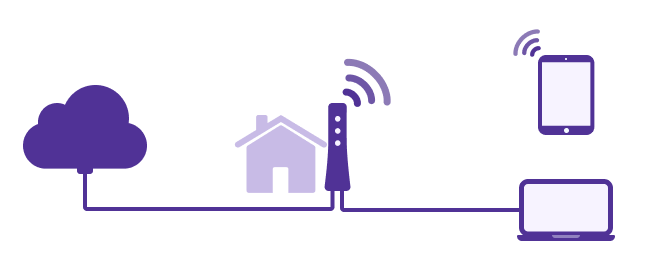En qué se diferencia la velocidad del plan de la velocidad de los dispositivos
La velocidad a un dispositivo casi siempre será inferior que la velocidad a una casa, especialmente, con las altas velocidades del servicio de fibra óptica.
Si realizaste una prueba de velocidad y te sorprendiste porque los resultados fueron inferiores a la velocidad total de tu plan, no te preocupes. Es normal. Aquí te explicamos por qué.
La velocidad que llega al hogar suele ser más rápida que la velocidad que llega a los dispositivos.

La velocidad que recibes en tu módem o SmartNID debe ser la velocidad total de tu plan. Por ejemplo, si tienes un plan de 940 Mbps, esa velocidad debería ser similar a la que recibes si pruebas tu velocidad en el módem o SmartNID usando la aplicación Quantum Fiber.
A medida que esa señal se distribuye por todo el espacio a través de Wi-Fi, se volverá más lenta. El grado de ralentización depende de algunos factores.
La velocidad se reduce al conectar más dispositivos

Cuantos más dispositivos tengas conectados a tu Wi-Fi, más lenta será su velocidad.
Con un plan de ancho de banda alto como 940 Mbps, comienzas con tanta velocidad que, incluso si ves 200 Mbps en un dispositivo, debería ser más que suficiente para la mayoría de las actividades comunes.
Cada dispositivo tiene una velocidad máxima

Todos los dispositivos tienen capacidades de velocidad máxima. Por eso, las velocidades más bajas podrían deberse a tu dispositivo y no a un problema con el servicio.
Los dispositivos más antiguos simplemente no fueron diseñados para las altas velocidades que puede proporcionar la fibra óptica. Si tienes dispositivos de varios años de antigüedad, su velocidad máxima podría ser de solo 100 a 150 Mbps.
Los dispositivos más nuevos pueden alcanzar un rango máximo de 200 a 300 Mbps. Como cada uno es diferente, si no estás seguro, consulta las especificaciones de cada dispositivo.
Este contenido se proporciona únicamente con fines informativos y es posible que el usuario final deba realizar una investigación y verificación adicional. Asimismo, la información es suministrada en el estado en el que se encuentra, sin garantía ni condición de ningún tipo, ya sea expresa ni implícita. El riesgo que implica el uso de esta información corre por cuenta del usuario final. Todos los nombres de empresas y productos o servicios de terceros mencionados en este artículo son solo para fines de identificación y no implican respaldo ni afiliación alguna con Quantum Fiber. Este documento representa los productos y las ofertas de Quantum Fiber a la fecha de su publicación. Los servicios no están disponibles en todos lados. Quantum Fiber podrá cambiar o cancelar productos o servicios, o reemplazarlos por productos o servicios similares, a su exclusivo criterio y sin previo aviso. ©2024 Q Fiber, LLC. Todos los Derechos Reservados. Quantum, Quantum Fiber y Quantum Fiber Internet son marcas comerciales de Quantum Wireless LLC y se utilizan bajo licencia de Q Fiber, LLC.
¿Fue útil esta información?








